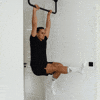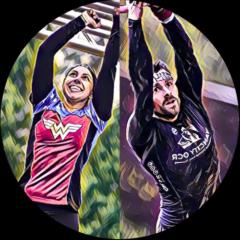Activity
Mon
Wed
Fri
Sun
Nov
Dec
Jan
Feb
Mar
Apr
May
Jun
Jul
Aug
Sep
What is this?
Less
More
Memberships
Awesome! Calisthenics (FREE)
354 members • Free
Become a Software Engineer
4.3k members • Free
Prometheus Code
35 members • Free
Bring Me in Korean
1.2k members • Free
JavaScript
245 members • Free
Python Developers
780 members • Free
AI Cyber Value Creators
6.7k members • Free
SAT Prep
11.9k members • Free
Gamify SAT
5.7k members • Free
7 contributions to Awesome! Calisthenics (FREE)
Secret Progressions: Leverage
One of the biggest breakthroughs most athletes miss is how much leverage changes a skill. Almost every advanced movement involves your legs comes down to controlling leverage. Planche, human flag, hollow body, front lever, back lever, etc... Think about it this way: when you’re doing a push-up, you’re pressing around 70% of your bodyweight. Move your shoulder forward to move into a planche lean, and suddenly you’re shifting more weight forward, massively increasing the load on your shoulders and core. That’s why progressions exist: tucked, advanced tuck, one leg, straddle, full. Each one shortens or lengthens the lever, giving you a way to control the load without needing weights. Sometimes progress is obvious (you unlock straddle). Other times it’s subtle, one inch or centimeter at a time in your lean or your leg extension. This is why patience matters. You can be “strong enough” for a skill, but if your body isn’t adapted to that exact lever change, you’ll slip out. That’s physics. 👉 Drop PROGRESSIONS in the comments if you want me to break down the exact path for the skill you’re working on right now.

How to Start Calisthenics from Zero
Most people who want to start calisthenics make the same mistake: they try to do everything at once. Handstands. Muscle-ups. Front levers. Planche. Flows. They build a 2-hour program filled with advanced skills, only to burn out in a week. Here’s the hidden truth: simple scales beat complex plans every time. All you need is to work on the foundations and that will help with everything you want to achieve. There are NO masters without the basics. Your real “Day 1” is about mastering control of your own body with basics. That would Be: 1 Push (push up, dips or pike push ups) 1 Pull (pull ups, inverted rows) 1 Squat/Hinge (Squat, Glute Bridge, Nordic Curl or Sissy Squat) 1 Core (Hollow Body or Leg Raises) That's it, there is your workout. Do as many as possible 1 after the other, takes about 5 minutes. Now you have no excuse that there is no time to get your workout in. These aren’t “beginner” moves, they’re the foundation athletes never stop training. The only different is they get harder progressions or more focused on their goals. Consistency is the real breakthrough. One minute of hollow hold every day builds more momentum than a 3-hour grind once a week. Micro-wins like holding a crow pose, or kicking up to the wall for 3 seconds, stack up faster than you think. That’s why in the Masterbook we give you all the skill timelines and the progressions for all the biggest movement patterns. Start smaller. Build momentum. Celebrate every rep of progress. 👉 Comment SIMPLE if you want me to share a simple starter plan with you personally.
How Do You Make Yourself More Flexible?
Here is a very general information dump on flexibility training, what it is, how long to do it and the best routine I found to get started. @Emma Liao, this should answer the question. Video Transcript (Cleaned Up) All right, let’s talk about flexibility. I figured I’d make a quick video about it since it’s already in the master book. I’m about halfway through the book, and I noticed flexibility is something we don’t often cover in depth. Before we move on to mobility and freedom of movement, I want to give you the basics. Flexibility vs. Mobility Flexibility is simply increasing your range of motion. Mobility is how well you can move through that range. For example, if you want the splits, you need flexibility training to get there. How to Improve Flexibility Research shows the most effective way is to hold a stretch for 30–60 seconds. Anything longer doesn’t seem to give extra benefit. Personally, I prefer closer to 60 seconds since it can take time to relax into the position. Flexibility is largely controlled by your nervous system. Your body limits range of motion to prevent injury. Stretching tells your nervous system, “This range is safe.” Over time, your body adapts. At extreme ranges, your muscles do lengthen a bit—similar to strength training adaptations. Think of kids: they’re naturally more flexible because their bodies haven’t locked into specific movement patterns yet. Intensity When stretching, aim for about 30% intensity—mild discomfort but no pain. You may have seen extreme methods where athletes are forced into splits. That can work for children, but for adults it’s dangerous. Why Flexibility Matters Your body restricts motion as protection. If you fell and your limbs overextended, you could tear something. Training flexibility teaches your body those ranges are safe, which actually makes you less likely to get injured. Mental vs. Physical Limitation Sometimes the barrier is physical tightness; other times it’s your brain saying “danger.” That’s the mind–body connection.

Freedom of Movement – Part 1: Misunderstood
Most people think “freedom of movement” is just another word for flexibility. Stretch more, touch your toes, maybe even hit a split — and you’re done. That’s the misunderstanding. 👉 Flexibility is passive. It’s how far you can go when gravity, a partner, or your own hands push you into position. 👉 Mobility is active. It’s what you can control on your own, like kicking your leg high and holding it there. 👉 Freedom of Movement goes beyond both Think of a gymnast flowing from handstand to roll to cartwheel. Or a parkour athlete vaulting, landing, and rolling without “thinking.” That’s freedom of movement. ⚡ Quick test you can try right now: Try a Turkish Get-Up with no weight. Lie flat on your back, roll to your side, press yourself to your elbow, then your hand, sweep the leg, stand tall, and reverse it back down. If you struggle to keep balance, control your joints, or stay smooth — that shows you’ve got flexibility or strength gaps stopping you from true freedom of movement. This is a more "traditional" way to add freedom of movement to your routine. However... There are more unconventional yet easy ways to get it. 👉 Comment “FREEDOM” if you want me to keep breaking this down. In Part 2, I’ll share how to actually build freedom of movement with progressions you can add into your training today.

Start Here: If you don't comment below you will be removed 😉
✅ Step 1: Introduce Yourself! 1️⃣ What is your Instagram so we can all follow each other? 2️⃣ What is your current goal? 3️⃣ What skill do you want to master in the future? 4️⃣ Post a picture of your currently workout spot 😉 ✅ Step 2: Explore the Free Classes & Challenges! 👉 [Click here to access your free training and get the most out of our community!] There, you will find a simple video tutorial on everything you need to get started.

1-7 of 7


